Books &Commentary 20 Dec 2011 07:42 am
Animation: The Whole Story – an Overdue Book Review
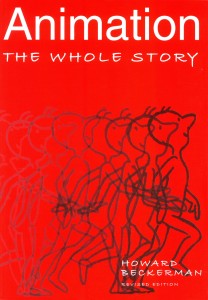 - Howard Beckerman‘s book, Animation: The Whole Story, published in 2003 by Allworth Press, comes close to being the book as described in the title. There’s an extensive history of animation, followed by a guide to animation production, followed by an analysis of the Business side of animation, and ending with exercises and a list of available resources (including schools, studio addresses, places to buy equipment and animation publications.) That’s a lot of book for the price.
- Howard Beckerman‘s book, Animation: The Whole Story, published in 2003 by Allworth Press, comes close to being the book as described in the title. There’s an extensive history of animation, followed by a guide to animation production, followed by an analysis of the Business side of animation, and ending with exercises and a list of available resources (including schools, studio addresses, places to buy equipment and animation publications.) That’s a lot of book for the price.
This is definitely a down and dirty book, just the facts ma’m, nothing but the facts, and for that I am grateful. There are no pretensions; in ways it reminds me of the Lutz animation book. The material is straightforward, and the presentation is complete. The illustrations throughout are done by Mr. Beckerman, himself, and the material is just about all-encompassing. I would use it as a classroom text were I teaching first level animation, and I’m sure there are many teachers who already do this.
There’s a lot of handy information in here, sort of an all-purpose guide to animation. It’s a bit like one of those tool boxes that have every 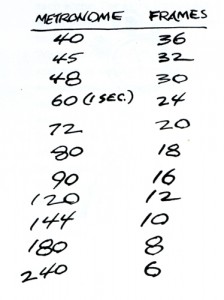 sort of wrench in it, so that you’re always prepared. There are directions for setting up a director’s workbook, how to do a storyboard, even a guide for properly flipping paper-drawn animation. There is an explanation of a field guide, frame to footage counters, information on how to build a drawing table light box, and even an explanation of exposure sheets – showing how to fill them out. I don’t think I’ve ever seen a book that transposes the meter on a metronome to frame counts. This has always been information handed down from one animator to another. Books don’t include it. This one does. This is incredibly useful for any animator looking to animate to a beat, and all animators SHOULD be doing that.
sort of wrench in it, so that you’re always prepared. There are directions for setting up a director’s workbook, how to do a storyboard, even a guide for properly flipping paper-drawn animation. There is an explanation of a field guide, frame to footage counters, information on how to build a drawing table light box, and even an explanation of exposure sheets – showing how to fill them out. I don’t think I’ve ever seen a book that transposes the meter on a metronome to frame counts. This has always been information handed down from one animator to another. Books don’t include it. This one does. This is incredibly useful for any animator looking to animate to a beat, and all animators SHOULD be doing that.
Howard Beckerman has been teaching animation and the history of animation in New York at the School of Visual Arts and Parson’s School of Design for a very long time. He’s also a professional having directed, designed and animated for many companies, including Paramount, as well as for his own company. He’s done many short films as well as written hundreds of articles for film and animation magazines. He knows his stuff.
This, to me, is most evident in the first half of the book, the history of animation section. This is a no-nonsense guide to the history from the beginning days right through the book’s publication date – 2003. In 85 pages he covers more material than many other elaborate and celebrated books. And the amazing thing is that it’s 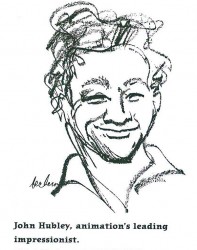 all accurate and correct material. I don’t think I’ve ever covered so much history – and it’s WORLD HISTORY – in so short a read. Yet it feels like nothing is left out. This is quite a feat. For my money. this is the absolute strength of the book.
all accurate and correct material. I don’t think I’ve ever covered so much history – and it’s WORLD HISTORY – in so short a read. Yet it feels like nothing is left out. This is quite a feat. For my money. this is the absolute strength of the book.
The weakness is one you can probably guess at from the descriptions I’ve already given. The book came out in 2003, and quite a bit has changed. There’s virtually no reason anymore to read about the Oxberry camera and how it works. The same could be said of the inking and painting of cels or even field guides and exposure sheets. Don’t get me wrong, I think it’s absolutely vital for everyone in the business to know this information, but I know it’s not part of the job anymore. Today’s book would be more about the computer: Flash and AfterEffects, Toon Boom Studio and FlipBook. The book is peppered with
caricatures of key people.
Perhaps someday there’ll be a new edition with more of that information. Although to be frank, there are hundreds
of books telling how to use the software. There are a lot of young kids making their animated films in Flash and calling themselves animators. Perhaps if they read this book, as it is, they’d have a bit more of a grasp as to what an animator does.
There’s so much in this book, I wholeheartedly recommend it if you’re looking for a great “how to” book. Even if you’re not, that history of animation section is world class.
Here are a few of the many illustrations in the book:
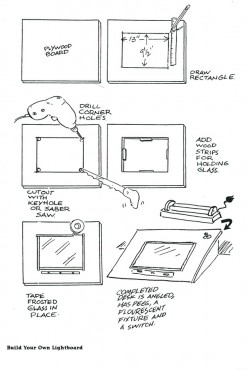
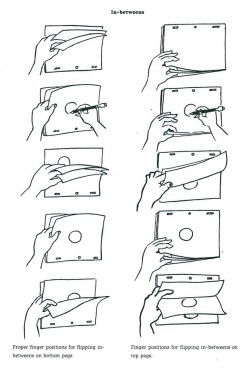
1. Building a lightbox - – - – - 2. Flipping and Rolling Animation - – - – - – - – - 4. How to Ink & Paint cels
It’s a practical little book, and is well worth checking out. (There are copies on Amazon that are incredibly inexpensive!)
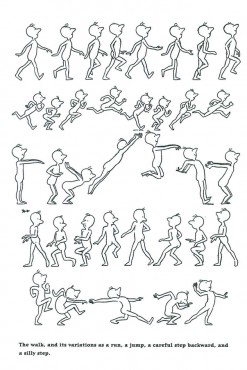
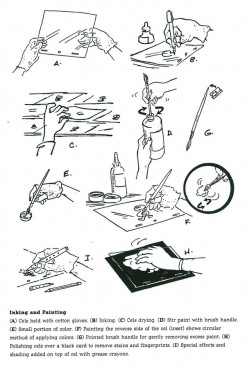
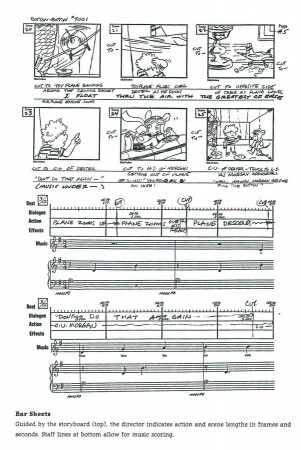

on 20 Dec 2011 at 12:19 pm 1.bill said …
Thanks for this post, Michael. I have always meant to get this book, but I never have. Now, thanks to your Amazon link, I will soon have it, and for under nine bucks! My Christmas present to myself.
Happy Holidays, Michael!
on 20 Dec 2011 at 12:33 pm 2.Oscar Solis said …
I found this book at the local library and kept renewing it because it was so fascinating. Even though I am not an animator (but have always loved animation), I am constantly on the look out for excellent books on the subject and techniques and I have to say I am in total agreement with everything you wrote. It’s probably the clearest explanation I’ve ever come across. If I wanted to start animating I’d probably grab this book first as a guide.
There was an interesting point made in the book where he writes about full animation and limited animation. He brings up a term “just enough” animation. I hope that’s the correct term (I don’t have the book in front of me but I will tonight after a visit to the library).
I like your comment about kids making films in flash and calling themselves animators. I notice that a lot of animation today is obsessed with technique. It’s the old “medium is the message” bit, I’m afraid.
on 20 Dec 2011 at 4:37 pm 3.Mark Sonntag said …
Thanks for the post. I haven’t animated in years and as I’m preparing to animate my CG short film I’m finding nyself going back to basics for a refresher. As I will be animating to music this is helpful indeed. I’m thumbnailing a lot of my work the old fashioned way and using x-sheets to plot my timing.
on 21 Dec 2011 at 7:06 am 4.Howard Beckerman said …
Wow! Thanks Michael. I appreciate your wonderful review of “Animation The Whole Story.” It pleases me greatly that you were so pleased with various aspects, especially the history. The book for me was what I had always wanted when I was a teenager and there was no guide rev ealing what an animator should know.
Yes, certain things now seem outdated. At the time I was completing certain chapters it was a crossover period for production on film and using cels. I just figured it would be a good idea to document those techniques for historical reasons. Anyway, I’m privileged to be included in the Splog. You may get some flak on the metronome/frame equivalents from your blog followers. Oh,there is a similar list, with slight differences, in one of Preston Blair’s books.
Howard